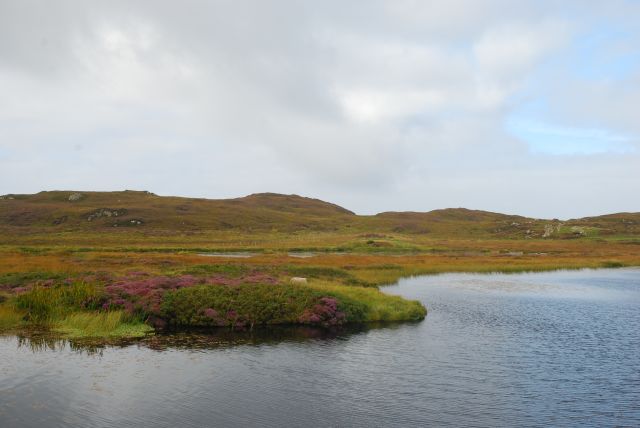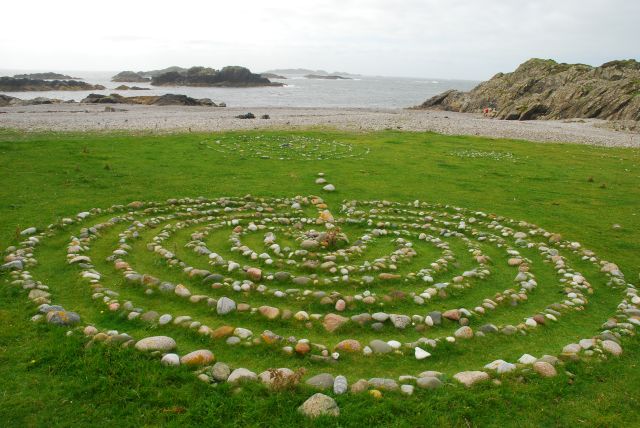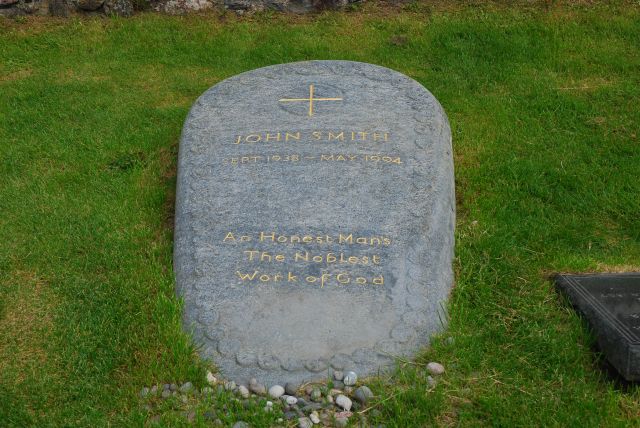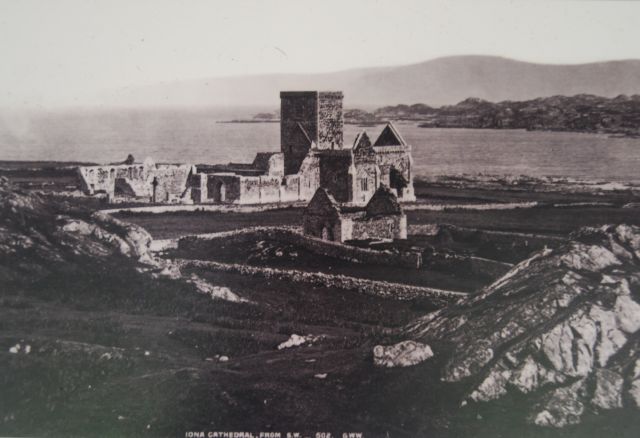On the far side of Iona is a bay of white sand and shingle where you can stand on the shore and look to the west, knowing that the next landfall is Newfoundland. It’s a magical place with an enchanting name – Camas Cuil an t-Saimh in Gaelic: the Bay at the Back of the Ocean.
And but for the sky, there are no fences facing…
We took the ferry to Iona from Fionnphort on Mull at ten o’clock on a bright Sunday morning. Leaving the ferry, most of the foot passengers headed towards Iona Abbey and the north end of the island, but our way took us south from the jetty, following the tarmac road past the island’s fire station and war memorial before turning inland to cross to the west side of the island. Where the road ends, we entered common grazing land that is also used as a golf course.
The lush green ground is another example of machair – the fertile grassland formed at the back of beaches where windblown shells and sand have improved the soil.
The Bay at the Back of the Ocean spreads out before us, where the machair ends and a bank of shingle fringes the beach sand. Here people have made circles and other shapes – a heart, a peace sign – from the colour-flecked stones washed ashore.
a wide stretch of sand
you walk out
into space
as to
an appointment
with so much
space around you
intention
drops from you
here is where
forward momentum
runs out in
pure extension
no longer
ahead of yourself
in imagination
nor behind yourself
pushing on
you walk
above yourself
space spreading round you
the sand
bearing your weight
– from Thomas A Clark, The Hundred Thousand Places
Finally we wrenched ourselves away from this beautiful place, taking the track uphill that opened up great views back across the bay and the machair. Half way up the rise we encountered a group of those nameless volunteers who help maintain the paths we walk on. This group were clearing the gullies across the path that drained away floods of rainwater from the rocky hillside.
At the top of the rise, the track reaches Loch Staoineig, passing to the left of the loch which, right up to the 1980s, provided Iona’s water supply (water is now piped across from Mull).
We continued south, eventually reaching a viewpoint overlooking St.Columba’s Bay, where St Columba stepped ashore in AD 563. In the middle of the bay is a hill known as the Hill of the Back to Ireland: it is said that Columba climbed this hill to make sure that Ireland was out of sight. He had left Ireland full of guilt at having triggered a clan war that left many dead, and had sworn that he would only settle when he longer had sight of his native land. He had previously landed at Dunaverty in Kintyre, but as Ireland was visible from there he sailed again until he reached this shore.
The beautiful shingle beach here is backed by a level meadow that must be a stunning sight in late spring because we found it covered in the leaves of the iris, yellow flag.
The pebbles from the beach here have often been collected by Christians who make the pilgrimage here. They are many and varied, very stone different in colour and texture. The stones flecked with slivers of green are sometimes called Columba’s tears or mermaid’s tears, and legend has it that if you carry a piece of Iona greenstone with you, you will never drown. These green and white pebbles are, in fact, examples of Iona marble, whose source is a unique small geological outcrop near the south end of the island where there once was a quarry. That was to be our next destination
I spent some time sifting through the pebbles, picking one or two to take home as a memory of the place. Then I noticed that on the grass beyond the beach pebbles had been carefully laid to create stone labyrinths, a symbol which seems to have a special resonance for those who come on pilgrimage here (the Christian tradition on Iona seeming to have a definite New Age or mystical tinge). We had seen one of these labyrinths, too, the previous day on the tiny island of Erraid where the Findhorn spiritual community has a settlement.
Intrigued at the ubiquitous presence of this symbol, I found that labyrinths have had a special meaning for human kind for well over 4000 years. There is evidence of the existence of the labyrinth symbol across southern Europe and North Africa from roughly 2000 BC, taking the form of rock carvings and paintings, inscriptions on ceramics, tiles and coins. The same basic design began to appear across Asia, the Americas and Southern Africa in an assortment of forms including rock carvings, wall paintings and wooden sculptures. Prehistoric labyrinths are believed to have served as traps for malevolent spirits or as defined paths for ritual dances.
Roman labyrinths took the form of mosaic pavement labyrinths laid in the floors of bath houses, villas and tombs throughout the Roman Empire. The medieval period marked a new wave of labyrinth building , especially the many labyrinths found in cathedrals and churches across Europe from the 12th and 13th centuries. The most famous medieval labyrinth of this type is the one laid down in 1201 in the floor of the nave of Chartres Cathedral. These labyrinths were built for walking. They offered a bounded space for personal reflection, a symbolic form of spiritual pilgrimage.
I live my life in widening circles
that reach out across the world.
– Ranier Maria Rilke
The next stage of our walk took us through very boggy ground where the path was faint or nonexistent. After a great deal of doubling back and forth, we reached the remains of the Iona Marble quarry, situated in a cleft running down to the sea between cliffs from which the stone had been quarried. The site may have been worked as early as 1745 by the Earl of Breadalbane when he founded the Marble and Slate Company of Netherlorn.
The quarry was officially opened in the late 1700s by the Duke of Argyll but did not operate for long because the marble was difficult to extract and transport was uneconomical. There was a failed enterprise by the Argyll Quarry Company in the 1800s, which hoped to extract the stone and ship it from the island on an industrial scale, but the remote and rocky location proved too hazardous for shipping. However, a final attempt was made to extract stone when the quarry reopened again in 1907. But it closed for the last time at the end of World War I.
Today all that is left are the very rusted remains of machinery from the pre-First World War period of quarrying – a large winch and cable, a cutting frame, water tank, gas engine – many of which have been painted black by the Scottish National Trust that looks after the site, now listed as a Scheduled Ancient Monument.
The return from the quarry to the village involved crossing another boggy stretch before, finally, we reached the end of the moor and saw the scattered houses on the outskirts of the village. We came down to the paved road and the shore just as a ferry approached the jetty. We had lunch and rested awhile at the Martyrs cafe before moving on to explore the northern part of the island.
As the road leaves the village it climbs slightly, passing organic vegetable gardens for two of the hotels before the ruins of Iona Nunnery appear on the right.
The Nunnery was built in 1203, one of only two houses of Augustinian nuns in Scotland. It was made derelict during the Reformation. The walls are of an interesting construction: pink granite blocks are interleaved between layers of slate. Despite its ruinous state, this is one of the best examples of a medieval nunnery left in Britain.
Next to the nunnery is St Ronan’s Chapel, a small building was the islanders’ parish church from around 1200 to the Reformation in 1560. Excavations have revealed that there was a chapel on the site as early as the 8th century. The chapel is surrounded by a graveyard which contains the graves of several Scottish kings as well as monarchs of Ireland, Norway and France. By the wall near est the sea is the grave of John Smith, former leader of the British Labour Party. His grave is marked by a stone with an epitaph quoting Alexander Pope: ‘An honest man’s the noblest work of God’.
John Smith died of a heart attack in 1994 at the age of 55. He is buried here because he and his family spent many summer holidays on Iona, a place he loved deeply. However, many islanders opposed the decision to grant John Smith – a mainlander who grew up in Argyll – a plot in a cemetery normally reserved for locals and their descendants.
Looking down at his grave, I remember the deep sense of shock among Labour party members and supporters at the time of his death. Although Smith was by no means a left-winger, a kind of wistful nostalgia for the Prime Ministership that never was has grown up among those for whom Tony Blair is an anathema, concisely expressed in the article, ‘What if John Smith had lived?’ by Francis Beckett in The Guardian last year. Who can say how things might have turned out – but I have a gut feeling that Smith would never have ignored the legal advice that an invasion of Iraq would constitute an act illegal in international law, or relied upon a meretricious dossier to justify the action.
Iona is a place of pilgrimage because this is where St Columba established his mission from Ireland in 563, credited with bringing Christianity to the Picts who inhabited Scotland at the time (though in this clip from the BBC series Scotland’s History, Neil Oliver questions the accuracy of that belief).
The abbey that stands beyond the graveyard belongs to a later era than Columba, who, seeking seclusion, had little interest in grand buildings. Almost nothing remains of the original monastery he established here but traces of the that surrounded the monastic enclosure that would have contained a modest timber church, surrounded by huts for the monks to live and work in, and small cells for solitude and prayer.
In 1203, the Lord of the Isles invited the Benedictine order to establish a new monastery, and the first Nunnery. The abbey has been restored. The Abbey was substantially expanded in the fifteenth century,but following the Reformation, was dismantled and abandoned. The building we see today was substantially rebuilt in the 20th century by the Iona Community. On the lawn outside the abbey is a board with this photo showing the ruins at some time in the late 19th century.
At the door of the Abbey stands a replica of the St John Cross (the original can be seen inside the Abbey). Carved more than 1200 years ago by craftsmen who worked at the abbey. It was just one of many crosses which showed pilgrims the way to the abbey, as well as being places where people would stop and pray as they passed by.

The original St John’s Cross is in pieces today. The carvers wanted to build a huge and impressive cross – but overdid it. The arms of the cross were too long, and it collapsed almost as soon as it was built. They tried to fix it by adding the stone rings, but that didn’t work for long either. In 1970 the replica cross, made of concrete, was built which now stands outside the abbey.

Just outside the Abbey stands St Martin’s Cross, another impressive cross with Celtic designs. It’s the most perfect of the surviving crosses on Iona, it still stands where the monks of the monastery placed it twelve hundred years ago. The cross is 17 feet hight and is carved from a stone that originally came from Argyll on the mainland. The raised circles, or bosses, are thought to represent God with everything revolving around Him. Intertwined between these bosses are serpents, which in the Celtic world represented rebirth since the snake sheds its old skin. The ring around the cross head represents eternal life and is a common feature in Celtic Crosses.
From the abbey, the paved road continues past the low hill of Dun I, the highest point on the island. Dun is Gaelic for hill, and I is what Iona was once called. The Hill of Iona is a place from which it is possible to see the whole of the island. From here, a path continues to the northern shore – but for us it was time to turn back to catch the last ferry returning to Mull.
At Fionnphort, the ferry was met by large wagons onto which catches of fish and seafood were being loaded. A large seal was in close attendance – we guessed it probably knew this happened at the same time every day, and anticipated being thrown some scraps.
See also
- Iona: Scotland’s History (BBC article and video clips, presented by Neil Oliver)






















I have really enjoyed you posts from Mull, such beautiful pictures and interesting histories! I would love to set out for a walk on these beaches!
Could you tell me who Thomas A Clark is? Are his poems written to this landscape?
He’s a Scottish poet whose poetry ‘has been consistently attentive to form and to the experience of walking in the landscape, returning again and again to the lonely terrain of the Highlands and Islands’ (Scottish Poetry Library page, which has a brief bio and some poems: http://bit.ly/NUAbyB). I guess some of these poems are inspired by the landscape around Pittenweem on the east coast where he now lives and works, but their beauty is that they speak of many places, outdoors, walking. As far as I’m aware he’s published three books: Distance and Proximity (Pocketbooks) which contains his famous prose-poem ‘In Praise of Walking’ (now out of print and going for ferocious second-hand prices on Amazon), The Path to the Sea, and The Hundred Thousand Places (the latter two both in print and available on Amazon). I hope that’s helpful. Thanks for commenting – I’m glad you have enjoyed the Mull posts – there’s still one more to come!
Thank you so much! I had to make a post on this! Hope it’s ok?!
No problem! Your blog looks interesting, too. I’ve started following it, and look forward to following your expeditions into nature writing and reading.
Gerry, I think you’d enjoy Adam Nicholson’s evocative and well-researched book “Sea Room,” which he wrote about the Shiant Islands (northwest of Mull).
Thanks for the recommendation, Alexandra. It’s in that pile of ‘books to be read’ already (there’s so many!). Last year I listened to Nicolson’s Dark Arcadia essays on Radio 3. There’s a review here: http://wp.me/poJrg-1Nt
Is there a building somewhere, or an object, made from the green marble? I’d like to see a photo of it. This was a lovely post, and I definitely felt the magic of the Bay at the Back of the Ocean.
Not buildings, Vicki, but ‘Since the 18th century small polished pieces of Iona Marble have been much prized by both collectors and jewellers. During the Victorian era especially, when Scottish jewellery became very fashionable due to Queen Victoria’s visits to and interest in the Highlands and Islands, jewellers made brooches and pendants incorporating polished sections of the green and white stone.’ (http://bit.ly/U4v9ww)
Great — thanks, Gerry! I’ll see if I can find some examples online.
What a lovely thing to find on my computer while reading an email from a friend.
I have spent several months on Iona and love it intensely.It really is an amazing place and if anyone reading your writing should feel like going, they should!
Iona is called ‘a thin place’ – where this world and spirit world are very close.At the physical level the white sandy beaches are wonderful and the corncrakes in the spring are delighful, if you can see them! At the spiritual and emotional level Iona will bring you a balm and a peace.
Many thanks.
Christina
Thanks, Christina. I’m glad to have brought a bit of pleasure to the day! I would like to return in the spring – I bet it is lovely at that time of year.
Wow, Iona. Will always have a special place in my heart. This is where I met my wife 5 years ago. We haven’t been back yet, but your post sure makes me want to!